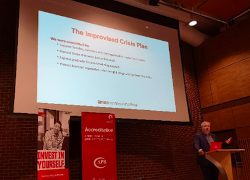 Grant Bastedo is the Founder and Principal of Takt Communications Agency
Grant Bastedo is the Founder and Principal of Takt Communications Agency
In the final Speaker Series event of the season, held on May 2nd at the SFU GoldCorp Centre for the Arts, attendees heard from Grant Bastedo, the Principal of Takt Communications Agency, and the communications lead behind the scenes the most talked about crises in recent memory: the Humboldt Broncos tragedy.
The Tragedy
On April 6, 2018, the Humboldt Broncos Junior A hockey team’s bus collided with a semi-truck on a highway north of Tisdale, Saskatchewan. The crash resulted in 13 injured and 16 deaths including 10 players, the bus driver, two coaches, the athletic therapist, a volunteer statistician and a broadcaster. The Broncos’ organization, overwhelmed and reeling from this horrific tragedy, engaged Grant Bastedo and his team from Takt Communications to assist with crisis management and media relations.
Handling the Crisis: Strategy and Improvisation
After getting as much information as possible, Grant and his mighty team of two, quickly created a Crisis Communications Plan. Their plan focussed on four objectives:
- Support families, survivors, and the organization. Ease their burden;
- Honour those who were lost and injured;
- Express gratitude for overwhelming support; and
- Protect the Bronco’s reputation – do the right things and rise from the ashes.
Challenges: Crisis within the Crisis
Given the magnitude of this crisis, the team faced several immediate challenges:
- Bronco’s website and social media channel passwords were lost with coaching staff that were on the bus, making it very difficult to spread important information online;
- A high volume of general public to offer condolences enquire about how to help, find out where to donate, purchase Humboldt gear and request information about funerals; and
- Unestablished points of contact with media, resulting in hundreds of calls on personal phones of Bronco’s Board members and the need to provide information to media outlets all around the world.
Crisis Response Priorities: Day 1
With the situation growing increasingly chaotic, the team implemented several important measures:
- Registered a dedicated 1-800 media line and email address to funnel phone calls to media team;
- Built – in only four hours - the crisis management website humboldtstrong.info where the public could find information about victim condition updates, family statements, Memorial Service details and how to donate;
- Created media release subscription database and sent a release using Cision newswire service; and
- Worked to gain access to the team’s Twitter and Facebook pages.
Media Protocol: Setting Limits
As the relationship between the grieving families and media became more complicated, Takt saw the need to establish protocols and guidelines to ensure media respected the privacy of those involved in both hospital and memorial settings. While failure to adhere to the protocol would result in access to spokespeople and events being denied, media were ultimately deferential and abided by the rules.
Important Lessons Learned
Some of the key lesson learned include:
- Prepare in advance, have a crisis communications plan in place;
- Save passwords where they can be easily found by others within the organization;
- Carefully choose spokespeople, be conscious of the volume of interviews being granted and potential for media fatigue;
- Confirm information before releasing it;
- Triage: you can only do what you can do, so prioritize;
- Quality and accuracy are essential even when under stress and time pressure;
- Manage emotional health: it sneaks up on you;
- Don’t be afraid of asking for help, but know who you are going to ask for help;
- Lay out the rules of engagement for media.
Crisis Plan: Be Prepared!
Grant also left us with some parting words of wisdom that we can all take back to our organizations for further thought and action when it comes to preparing for crisis situations:
- Identify potential crisis situations unique to your organization;
- Identify crisis support team (PR, legal and crisis counselling) and assign roles for: decision-making, spokespeople and who is to communicate with different stakeholders;
- Ensure access to necessary information and passwords;
- Notifications: phone tree, push notifications, etc.;
- Crisis website/intranet ready to go live;
- Key messages and prepped documents with vital information;
- Update and revise annually and post-crisis;
- Provide media training for spokespeople; and
- Create a simulated crisis scenario with your team to test the effectiveness of your plan and analyze how they can deliver under pressure.
About the Author
Paula Schütt has a bachelor's degree in Public Relations from UNIVALI and a marketing certificate from Arbutus College. She has over 3 years experience working both in agency and in-house settings for companies in the fitness, logistics, accounting and cosmetics industries. LinkedIn: @paulaschutt